About
03

About01.
What is protein?
About02.
Why is the study of proteins important?
About03.
Protein structure determination
About04.
Proteins around us
Proteins are at work around you.
Have a quick look at some examples.
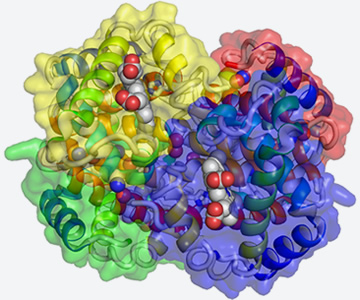
Human Deoxyhemoglobin
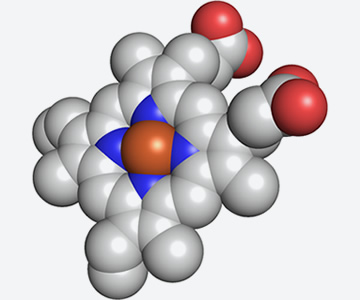
Heme group (carbon in white, nitrogen in blue, oxygen in red, and iron in brown)
All vertebrates including humans and some other animals have red blood cells, which are essential components of their blood.
Hemoglobin is a protein in red blood cells and carries oxygen from the lungs to the heart.
The red color of human blood is from a pigment called heme. It is a compound with an iron atom at the center, which binds to an oxygen molecule.
Hemoglobin is a tetrameric molecule, composed of two alpha and two beta subunits.(*1) The heme iron of each subunit can bind one oxygen molecule.
Cooperativity is the most important characteristic of hemoglobin. Binding an oxygen molecule to any of the four subunits enhances binding to the rest, while dissociating it from any subunit facilitates releasing from the other subunits.
Thus hemoglobin binds oxygen easily in the lungs where the oxygen level is high, and quickly releases oxygen in cells where the oxygen level is low.
Oxygen binding to hemoglobin is tightly regulated in our body. Search online for hemoglobin with the keywords "Bohr effect," "BPG" and "myoglobin" to find more about it.
Many arthropods including prawns and crabs, and mollusks such as shellfish, squid and octopus have blue blood as they use a cupper containing protein, hemocyanine instead of hemoglobin.
(*1) A structural unit in a complex or multimeric molecule.

Luciferase
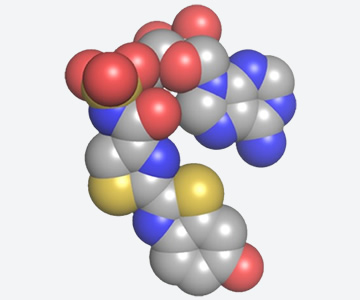
Luciferin
(carbon in gray, nitrogen in blue, oxygen in red and sulfur in yellow)
The glow of fireflies is a type of bioluminescence that involves an enzyme called luciferase.
The substrate(*1) of luciferin reacts to adenosine triphosphate (ATP)(*2) and produces oxyluciferin via luciferyl-AMP intermediate. The product of this reaction is in an unstable excited state, but transitions to a stable ground state by releasing extra energy that we see as a greenish yellow light.
By replacing certain amino acids in the enzyme, the color of the light can be changed.
Search online for luciferase with the keywords "ATP," "excited state" and "ground state" to find more about it.
(*1) In enzymatic reaction, a substrate specifically binds to an enzyme that catalyzes the reaction.
(*2) Adenosine triphosphate (ATP) is responsible for storing and releasing energy in cells, and often called "the currency in living organisms."

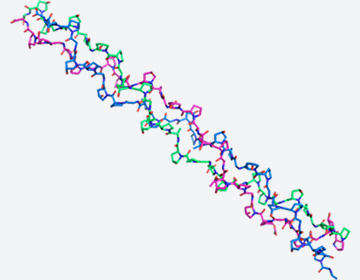
Collagen
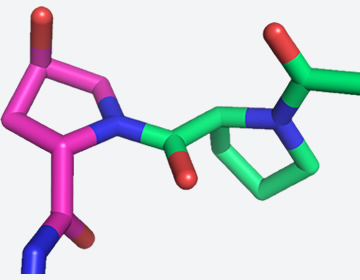
Hydroxyproline (left) and proline (right)
Collagen is a protein that helps to maintain the elasticity and firmness of our body parts, including skin, bone, and muscle tissues such as cartilage, tendons and ligaments. Proteins are generally composed of 20 kinds of amino acids. The amino acid composition of collagen, however, is unique and uneven: roughly 33% glycine, 21% proline, and 11% glycine. In addition, parts of the proline residues are modified to hydroxyproline, which is rarely found in other proteins.
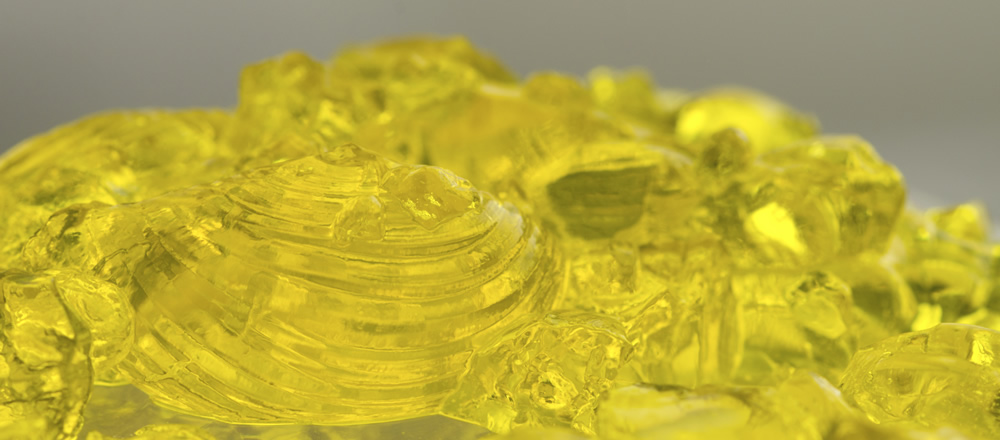

Norwalk virus capsid
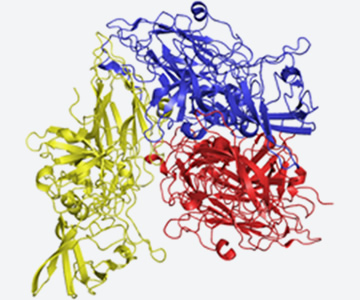
A repeating unit of the capsid protein
Norwalk virus (also known as Norovirus) is the most common cause of food poisoning. Norovirus has no cell, but has its own genes in a protein shell called capsid. It propagates by using the cells of other organisms.
The origins of viruses are unclear. One of hypotheses is that viruses originated from transposons. A transposon is a DNA sequence capable of translocating its position within the genome(*1). The first transposon was found in corn. Now, 80% of the corn genome and 40% of the human genome are derived from transposons or the derivatives thereof.
(*1) All genetic materials (i.e. DNA, RNA) of an organism.
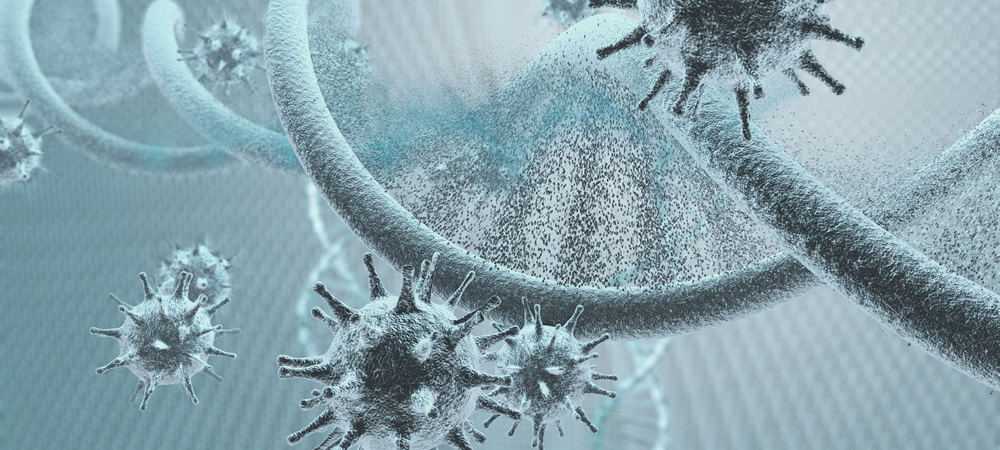

Alkaline Protease
Alkaline proteases are often found in laundry detergents. Proteases are a type of enzyme that breaks down proteins. Among them, alkaline proteases maintain high enzymatic activity in an alkaline condition. Dirty laundry contains fat and proteins. An alkaline solution dissolves fats into the solution and alkaline proteases break down proteins. Laundry detergents are thus more effective with this combination.
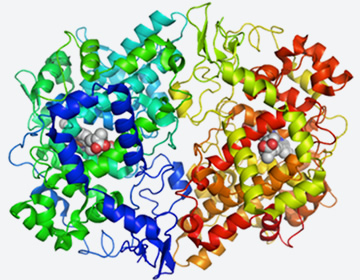
Cyclooxygenase-2
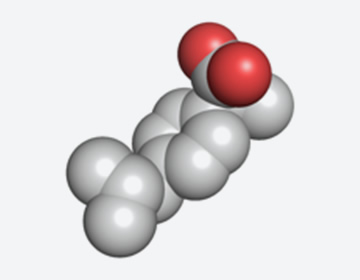
Ibuprofen
Cyclooxygenases are proteins involved in a pathway to produce prostaglandins from arachidonic acid in cell membranes(*1). Some prostaglandins induce fever and increase pain. Ibuprofen, which is often formulated in pain relievers and fever reducers, inhibits cyclooxygenase activity by occupying its arachidonic acid binding site. As a result, prostaglandin synthesis is suppressed and you'll feel less pain and fever.
(*1) Biological membrane dividing the inside and outside of a cell.

How ibuprofen works
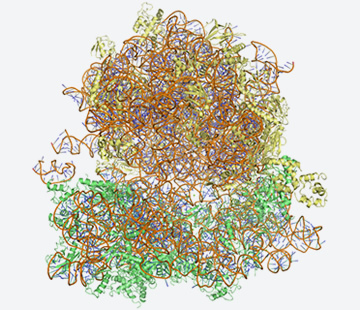
ribosome
Ribosomes are gigantic complex molecules, consisting of more than 50 different proteins and at least three different RNA molecules. These molecules exist in any organism and synthesize proteins in a process called transcription. The transcription rates of bacterial ribosomes are about 20 amino acids per second (equivalent to 60 bases on average), while the rate of eukaryotic ones are 2-4 amino acids or 6-12 bases per second.
Mitochondrion, an organelle found in eukaryotic cells, has its own ribosome. Interestingly, it has more in common with the ribosome from bacteria than with the one from eukaryotes. Many studies suggest that mitochondria originated from bacteria taken in by the eukaryotic cells of our ancestors.
As you read above, luciferase, alkaline proteases, and cyclooxygenases are enzymes or biological catalysts. Given their function, ribosomes can be considered an enzyme, but their active sites consist of RNA, not proteins. In fact, some RNA molecules that can act like an enzyme are called ribozymes (as in ribonucleic acid combined with enzyme).
DNA is a blueprint of proteins, but its duplication requires proteins. Thinking about the origin of life may raise the question of whether the "chicken or the egg" came first. Many hypotheses have been proposed but we still don't know the answer. The most convincing one is the RNA world hypothesis. The discovery of the ribozyme, thereby confirming that proteins are no longer the only possible biological catalysts, suggests that "the RNA world" could be involved in the beginning of life. Many people still support other hypotheses including the one proposing that the first life on Earth came from Mars. More time is needed to settle the issue.
These discussions provide us deep insights on such questions as "what is life?" and "what does being alive mean?" Today, the working definition of life is something consisting of a cell (or cells) and capable of self- proliferation and metabolization. However, we only know life on Earth. According to NASA chief scientist Ellen Stofan, "I think we're going to have strong indications of life beyond Earth within a decade, and I think we're going to have definitive evidence within 20 to 30 years." The current definition of life could be totally rewritten when they find life elsewhere.
For more information on the origin of life, follow the links below.
http://evolution.berkeley.edu/evolibrary/home.php